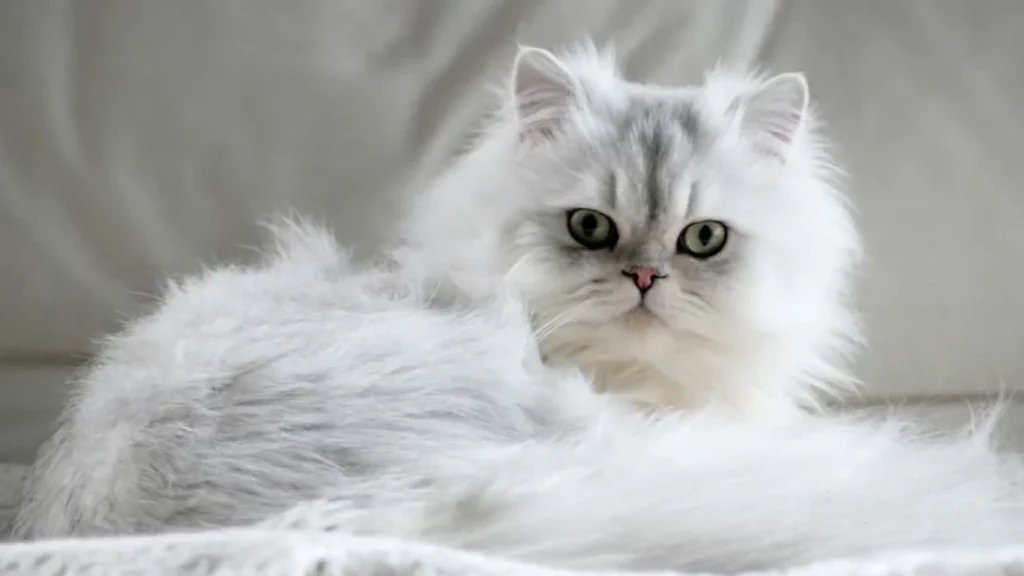Persian Cat Lifespan: Understanding Factors That Affect Their Longevity
By: Dorris Abraham

The information in this article is intended to educate cat parents and is not a substitute for veterinary guidance. In case of any concerns about your cat’s health, please talk with your veterinarian.
Persian cats are well-known for their beautiful appearance and calm demeanor. When considering bringing one into a home, prospective owners often wonder about the lifespan of these elegant pets. Typically, Persian cats can live anywhere from 10 to 17 years, depending on their health, lifestyle, and care.
Providing a healthy environment for a Persian cat can greatly impact its longevity. Regular veterinary check-ups and a balanced diet are essential in preventing common health issues associated with the breed. These cats are generally indoor pets, and keeping them inside can contribute to a longer life due to reduced risks from accidents or illnesses.
Understanding the factors that affect the lifespan of Persian cats will help owners give their pets the best chance for a long, happy life. Being informed about their needs and potential health issues is crucial for anyone considering this cherished breed.
Click to explore: Silver Siberian Cat Breed
Understanding Persian Cat Lifespan
Persian cats have a varied lifespan influenced by several factors, including genetics, health issues, and overall care. Understanding these elements can help owners provide a better quality of life for their furry companions.
Average Lifespan and Factors That Influence It
The average lifespan of a Persian cat ranges from 10 to 17 years. Several factors affect this range. Indoor cats generally live longer than outdoor ones due to reduced risks from accidents and diseases.
Key influencing factors include:
- Diet: High-quality nutrition supports overall health.
- Regular Vet Check-ups: Early detection of health issues can prolong life.
- Grooming: Regular grooming prevents matting and skin conditions.
Maintaining a healthy weight is also vital, as obesity can lead to serious health issues.
Interesting Read About World’s Smallest Cat Breed: Toybob Cat Breed
Common Health Problems in Persian Cats
Persian cats are prone to specific health issues that can impact their lifespan. Some common problems include:
- Dental Disease: Due to their flat face, they often face dental issues.
- Breathing Difficulties: As a brachycephalic breed, they can have respiratory challenges.
- Eye Problems: Conditions like progressive retinal atrophy can affect vision.
- Kidney Disease: Polycystic kidney disease is common in this breed.
Regular vet visits can help catch these diseases early, improving the chance of a longer life.
The Role of Genetics in Persian Cat Longevity
Genetics play a critical role in determining the longevity of Persian cats. Many inherited conditions, such as hypertrophic cardiomyopathy and certain types of cancer, affect lifespan.
Important genetic considerations include:
- Lineage: Cats from healthy, well-bred lines usually have fewer genetic problems.
- Screening: Genetic testing can identify potential issues early.
Choosing a responsible breeder who screens for genetic conditions can lead to a healthier, longer-lived pet. Understanding the genetic factors at play can empower owners to make informed choices for their cats.
Caring for a Persian Cat to Maximize Lifespan
To help a Persian cat live a long and healthy life, it is essential to focus on their nutrition, regular veterinary care, and opportunities for exercise and mental engagement. Each of these areas plays a significant role in overall well-being.
Proper Nutrition and Diet
Diet is critical for a Persian cat’s health. A balanced diet should include high-quality cat food that meets their nutritional needs. This diet helps prevent obesity, which is common in indoor cats and can lead to serious health problems.
Wet food is especially beneficial. It provides hydration and can help reduce the risk of urinary issues. Additionally, feeding smaller portions throughout the day can help maintain a healthy weight.
Some owners choose to include treats, but moderation is key. It’s important to avoid overfeeding, as this can lead to weight gain and related health issues.
Regular brushing is also necessary. Persian cats have long fur that can trap food particles. Reducing hairballs and maintaining a clean coat promotes better health.
Click to explore: Majestic Siamese Cat Breed
The Importance of Routine Veterinary Care
Regular check-ups with a veterinarian are vital for detecting health problems early. Routine vaccinations and dental care, including cleanings, help prevent common health issues like dental disease and infections.
During visits, the vet can monitor the cat’s weight and overall condition. This helps catch any health concerns before they become serious.
It’s also important to discuss flea and tick prevention, as these parasites can cause discomfort and diseases. Scheduling annual or bi-annual wellness exams ensures that the cat stays on track for a longer life.
Exercise, Play, and Mental Stimulation
Persian cats need regular exercise and mental stimulation to stay healthy. Interactive toys, such as laser pointers or feather wands, encourage playful activity and help burn off energy.
Setting aside time each day for playtime can be very beneficial. Not only does it keep them fit, but it also helps strengthen the bond between the cat and its owner.
Creating an indoor environment that allows for climbing, scratching, and exploring can also keep a Persian cat active and engaged. This helps reduce boredom and related behavioral problems.
Balancing these activities with rest ensures that they remain happy and avoid stress.
The Impact of Environment on Persian Cats
The environment plays a crucial role in the health and happiness of Persian cats. Factors such as living space and daily routines can directly affect their lifespan and overall well-being.
Indoor vs. Outdoor Living
Indoor living is often the safest choice for Persian cats. Indoor cats are less exposed to dangers like traffic, predators, and diseases. These cats can enjoy a consistent routine, which is essential for their well-being. Persian cats thrive in a gentle, calm environment where they can relax and feel secure.
On the other hand, outdoor living can offer more stimulation and joy. Outdoor cats may enjoy exploring and engaging with their surroundings. However, they face various risks such as injury and illness. Many breeders recommend keeping Persian cats indoors to protect their health, focusing on creating a fulfilling indoor life.
Creating a Safe and Enriching Home
To create a suitable home for a Persian cat, it is important to focus on their unique personalities. These gentle and friendly cats prefer cozy spaces where they can relax. Providing soft bedding and quiet areas helps them feel secure.
Incorporating toys and climbing structures can keep cats mentally stimulated. Regular interaction is vital as well; playing with them strengthens their bond.
Maintaining a clean environment is crucial. Regular grooming is essential for Persian cats, as their long fur can mat easily. This not only enhances their appearance but also promotes overall health. Neutering or spaying can also play a role in ensuring a balanced environment.
Frequently Asked Questions
Many people have questions about the lifespan and health of Persian cats. This section addresses common inquiries regarding their life expectancy, health issues, and development.
Conclusion
Persian cats, with their luxurious coats and gentle demeanor, can live a fulfilling life of 10 to 17 years when provided with proper care. Their longevity is influenced by factors such as diet, regular veterinary check-ups, and a safe indoor environment. By addressing common health issues like dental disease and respiratory challenges, owners can significantly enhance their Persian cat’s quality of life.
Understanding the unique needs of Persian cats, from grooming to mental stimulation, is key to ensuring they thrive. With the right care, these beloved companions can enjoy a long, healthy, and happy life, making them a cherished addition to any home.

About the Author
Dorris Abraham
Dorris, a skilled writer with a degree in English, combines her lifelong love for cats with years of expertise in feline behavior and care. A proud pet parent and passionate advocate for pedigreed and fluffy breeds, she creates authoritative, engaging blogs that inform and inspire cat lovers everywhere.
